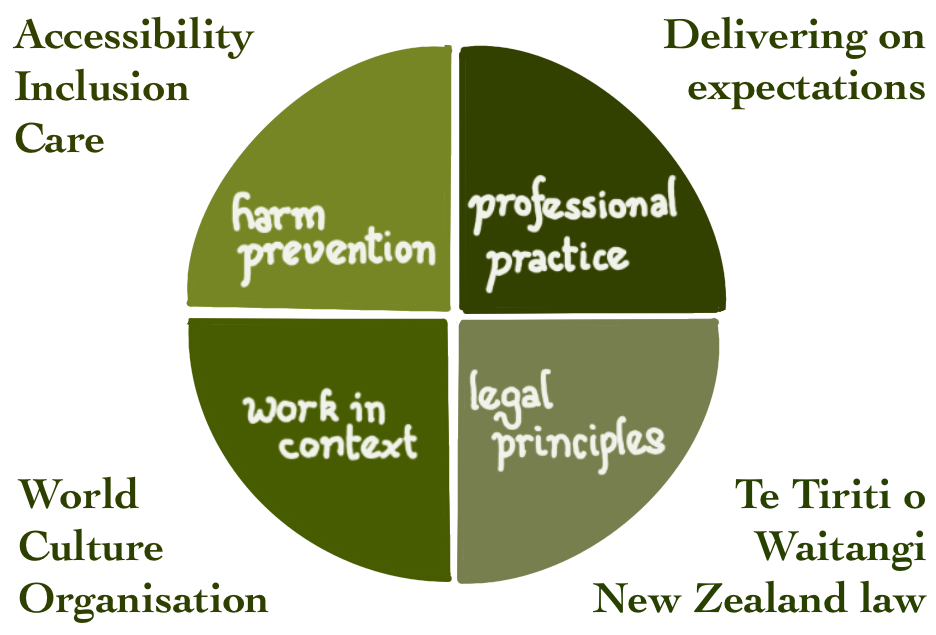Ethics of learning design
“What makes teaching a moral endeavor is that it is, quite centrally, human action undertaken in regard to other human beings. Thus, matters of what is fair, right, just, and virtuous are always present.” Fenstermacher, G. D. (1990).

What makes teaching a moral endeavor is that it is, quite centrally, human action undertaken in regard to other human beings.
Thus, matters of what is fair, right, just, and virtuous are always present.
G. D Fenstermacher, 1990
Have you ever thought about how to protect learners and teammates when you are designing training on subjects that could be traumatic or triggering, or about how to include marginalised groups and honour Te Tiriti, or about climate change issues for training?
Or if you haven’t, should you?
Learning designers work with people, and as Fenstermacher points out, if we work with people, then ethics matters.
‘First, do no harm’ (not just for doctors)
Learning designers can hurt people — a lot of people.
Making people feel like they’re not part of the group is harmful in its own right. And it can be harmful if it stops them from engaging with learning that benefits the learners. It can also be harmful or dangerous if we reinforce damaging stereotypes that reduce people’s opportunities and expose them to the risk of violence. And it can be dangerous if feeling excluded means they fail to engage with safety training.
Picking up on the failure to engage: if we design learning interventions that help people with their jobs, or help them to stay safe, then if we don’t make it accessible as well as inclusive, we are basically disadvantaging or endangering the people who cannot access the learning.
As learning designers, we have the responsibility of care that is implicit in any job where there are people, and a power imbalance. We are the ones controlling what information is available in our work, and how it is shared. We are therefore responsible for making sure it is shared safely and in a way that supports the mana of everyone involved. Manaakitanga matters. Protecting and supporting our learners is an automatic responsibility for us, the same way protecting the driver, passengers, and passersby is a responsibility for a car designer.
What do we need to look out for?
- Putting learners in situations where they don’t feel safe, physically or emotionally.
- Causing learners to feel inferior or to lose confidence in themselves. Creating too much stress or anxiety, or demotivating people.
- Reinforcing negative stereotypes of groups of people.
- Using case studies that are too close to the truth, or include identifiable people or situations, if that could trigger trauma reactions from those people or from learners or trainers.
- Not providing adequate support for trainers if they’re dealing with possibly-traumatic subjects. A trainer might be able to teach about a subject, but it doesn’t make them qualified to deal with a learner’s trauma, if that person encounters something that brings it up for them.
It’s a lot to think about. And we can’t always get it perfect. But that doesn’t absolve us of the responsibility of trying.
Supporting inclusion
Nothing about us, without us
To be effective in creating inclusive learning experiences, we need to do more than setting an aspiration to be ‘inclusive’. This sort of lip service does nothing. Instead, we can use systems and processes that will help us to include people. I see this as having four main aspects:
- Checking our work for accessibility
- Using systems to correct for unconscious bias
- Recognising and preventing microaggressions and othering
- Including members of groups who may be vulnerable to being excluded in our design phase — ‘Nothing about us, without us’
If we include explicit steps in our design reviews where we check that we are meeting defined standards for accessibility and look at examples, images, and scenarios to makes sure we aren’t promoting stereotypes or missing out vulnerable groups, then this cuts out a lot of the places where our work could exclude people, or promote harmful stereotypes.
But also, we need to educate ourselves enough that we can recognise what stereotypes are harmful, and who is vulnerable. It is all very well to do a review, but if one is not familiar with the issues, one won’t spot biases portrayals as harmful.
If we haven’t personally dealt with the mental load and stress that come with being repeatedly excluded, or seeing negative stereotypes of ourselves over and over, it can be harder to recognise which parts of popular culture are causing harm. But many small pinpricks can and do cause serious harm, and if we are going to educate people — especially if we are creating compulsory training that people cannot avoid — we owe it to everyone to learn enough to recognise what the issues are. (Also important if we just want to be decent people.)
And this brings up the last, and probably the most important, aspect of supporting inclusion: including members of minority and disadvantaged groups in design where possible. Where not possible, then making sure to research what they have said works for them. But there is only so far that goes.
As a field, learning design does a lot of talking about making things work for learners with low literacy, or who don’t speak the language of instruction fluently. But how often do we actually work with these people in our design phase, to make sure what we are doing actually supports them?
Similarly, I see a lot of posts out there lately talking about how to include neurologically diverse learners, but it’s almost all people setting out broad principles.
Nothing can replace just working with a real human being before all the design decisions are locked in.
Trauma-informed practice
Quite a few of my projects in the last few years have involved a subject-matter expert talking about trauma-informed practice.
This is a framework for thinking about problematic behaviour that goes from ‘what is wrong with you’ to ‘what happened to you’. By taking people’s histories, and possible histories, into account, we can improve interactions and empower people who have traditionally been disempowered. It’s good for helping people to have safer interactions in fields like community housing, medicine, social work, child safety, education, and so on.
Sounds great, yes, but what is the relevance to learning?
In workplace education, we are always dealing with people, and we are trying to support them in doing their jobs better: more safely, more effectively, and sometimes even more enjoyably.
But all our learners come into the classroom, or wherever they are learning, with their histories. They may have had poor experiences of education. They may have had other experiences that make the learning more difficult.
Trauma-informed practice provides a model for how we can think about making safe learning environments that feel trustworthy for the learners. We can draw on concepts around peer support, collaboration and mutuality, and empowerment and choice. This way, we can make learning that is safe for everyone.
As a very small example, let’s look at the common practice of ‘locking’ the screens in an e-learning module, and having a single learner work through the activities in a specific order. If we are thinking in terms of empowerment, transparency, and peer support, we might reenvision the module as a resource, which learners can make their own decisions about. Thinking of the learners as people, with social connections and their own needs, we might unlock the module, give clearer guidance about what each section has to offer, and recommend that learners be encouraged to work through it together, in pairs or small groups.
Another small example is with the knowledge check quizzes so popular in e-learning. It’s great to provide people with opportunities for formative assessment as they go, so they can check they are understanding things correctly. But many learners have had poor or distressing experiences with tests. While it may be clear to me that a formative assessment is intended as support, they may see it as a repeated high-stress judgement on them as a person. It’s not hard to add a brief explanation explaining why the quiz questions are there, and telling the learners that their results on these are not being stored. Hopefully, they can then focus on the learning, rather than fighting off adrenaline.
Learning activities that actually work
There‘s one more thing in there that I think needs to be called out: people who are taught badly are thereby harmed.
- If we teach something to someone so that they do it wrong, this causes harm to their self-confidence. Learners often blame themselves when they have had lessons in something and still cannot do it.
- If we teach something to someone so they do it wrong, this can also risk harm if their resulting actions hurt someone. For example, if someone is taught that non-painful burns are not serious, then they might not get medical help for a serious injury, or might not provide help if someone else needs it.
These are just examples, but with generative AI becoming one of the most popular ways for people to learn, this risk of people being taught incorrectly is becoming more and more serious. The internet is covered with jokes showing times where AI has given spectacularly bad advice when people have sought to learn from it.
Correct information
People trust published learning resources to a surprising extent. (I’ve seen some really poor quality control on e-learning, particularly, in my time.) Most learners tend to trust the correctness of what they are taught.
With the growing prevalence of AI ‘workslop’ (poorly written, ill-checked AI-generated content, which achieves nothing and takes time away from valuable tasks if you read it), the role of the learning designer in vetting becomes more and more critical.
Workslop has always existed. I’ve started a lot of projects being told to ‘package’ a slideshow and some largely irrelevant PDFs into a module, as if that will achieve any particular result beyond boring or possibly mystifying the learner. The last time this happened for me was this week.
So this role in vetting content to ensure that what we share with learners is both relevant and accurate isn’t new. What is new is the volume. But just because there is a lot of AI-produced content available, the task is still the same: ensuring that the learning activities we make don’t harm anyone, and do achieve meaningful goals.
Delivering on expectations
Learning design is a relatively new profession. Not all learning designers are members of a professional organisation with a code of conduct or minimum standards. There are a lot of people out there who don’t have those guard rails.
Devlin Peck quotes Cathy Moore as saying in Map It that,
Instructional design isn't a profession because we don't have a code of ethics.
Peck then agrees,
she's right. We don't have a code of ethics. In large part, we design courses, workshops, and flashy, gamified microlearning modules because that's what our clients are paying us for (or what the higher-ups at our orgs are asking for). If we're to maintain the integrity of our field, then this needs to change.
Moore wrote her book over eight years ago, and Peck wrote his post two years ago.
In New Zealand, our local professional organisation NZATD has had a compulsory code of practice for quite some time. And for those of us covered by it, or by similar codes, like the AITD Code of Ethics and Professional Practice, we have to stick to what we’ve agreed.
The NZATD Code of Professional Practice says I’m going to do some pretty clear things:
Work to the highest legal and ethical standards.
Establish measurable plans and use suitable methods and media to ensure that those for whom they have a responsibility for training and development meet agreed learning objectives.
Refrain from discriminating between individuals solely on the grounds of sex, race, status, age or beliefs, and to respect the dignity and privacy of the individual.
Pay proper regard to the health, safety and wellbeing of the personnel within their responsibility.
Do these look familiar? They have a lot in common with the inclusion, safety, accessibility, and manaakitanga I was just talking about.
So harm prevention isn’t only something I believe matters. It’s also something my profession thinks matters: enough to make it compulsory. It’s about both my own professional reputation, but also the integrity and credibility of the profession.
If you are part of any professional body, you have almost certainly signed up to similar commitments.
Learning activities that actually work
The NZATD code of practice emphasises the expectation for learning designers to develop learning that works. It requires me to “Establish measurable plans and use suitable methods and media to ensure that those for whom they have a responsibility for training and development meet agreed learning objectives.”
And yet, when I look at our field, I see so many, many learning activities with no actual way to tell whether people are learning anything, and evaluation is avoided or ignored far too often.
I also see more and more the idea that subject matter experts should go back to running unassisted live training and directly creating e-learning modules using AI to build the resources.
But subject matter experts haven’t studied what makes learning activities that work, and AI has no ethical standards at all.
When learning designers create learning activities that cannot be evaluated, or that will fail any evaluation, because the objectives described are not meaningfully taught, we are doing no better than the AI replacements that are being advertised.
As a profession, we need to hold our work to the basic standards of developing effective training, with clear ways to demonstrate the effectiveness.
Legal frameworks
New Zealand law also says things that are relevant here.
Fair Trading Act 1986
The Fair Trading Act says that,
a trader needs to have reasonable grounds to make a claim about a product or service at the time they make the claim. They're breaching the Act if they make a claim they can't back up with evidence, even if it later turns out to be true.
ConsumerProtection website, 2025
This means that anyone offering learning design services commercially actually must be providing work that includes clear ways to judge the effectiveness of the learning activities. It makes no difference whether a trader intends to deceive, or just doesn’t know what good looks like.
The Act applies to,
all commercial activities, trades, professions, and businesses
ConsumerProtection website, 2025
Other aspects of our legal framework
The other aspects of New Zealand’s legal framework that may affect us are:
- Te Tiriti o Waitangi 1840, which affects everyone working on behalf of the Crown (it also can be viewed as the first immigration document, setting out an agreement for the rules for immigration to this country, and thereby applying to immigrants after 1840 their descendents as Tangata Tiriti)
- Human Rights Act 1993, which establishes protection against discrimination for everyone on the basis of race, ethnicity, gender identity, sexual orientation, childhood, pregnancy, relatives, family violence, disability, employment status, political views, age (over 16), or religion
- Copyright Act 1994, affects what uses we can and can’t make of other people’s writing, art, recordings, code, and so on (this basically sets out the rule that if I publish someone‘s work, I must both identify them and have their permission, unless they have put the work in the public domain or died over 75 years ago)
- Health and Safety at Work Act 2015, requires that workplaces (the places we design activities for) take all reasonable steps to protect staff safety
- Privacy Act 2020 protects people’s personal information, saying that we cannot share it without their permission, and giving rules for how we store it and ask for it.
As a learning designer in New Zealand, I have to have at least a basic understanding of how all these apply to my work, so I can be sure I’m not breaking the law.
Our work in context
With all these considerations in mind, we also need to think about how the ethics of learning design apply in context.
The process of our work can help or hinder improvement in a wider context than just the learning interventions we work on. We are also always affecting things at three higher levels:
- The organisations we are working for
- Our wider culture
- For the whole world.
Our actions can be as small as holding online planning sessions, instead of flying, to save on carbon emissions, or using reusable cups for meetings, to avoid plastic waste. They can be applying small social pressures towards inclusion, like asking how Māori approaches to learning will be included our work, rather than whether we need to think about it. They can be considering the energy-use implications of internet searches and AI use, and avoiding frivolous or pointless searches.
How we work can contribute to making the world a better or worse place, just as much as what we teach.

